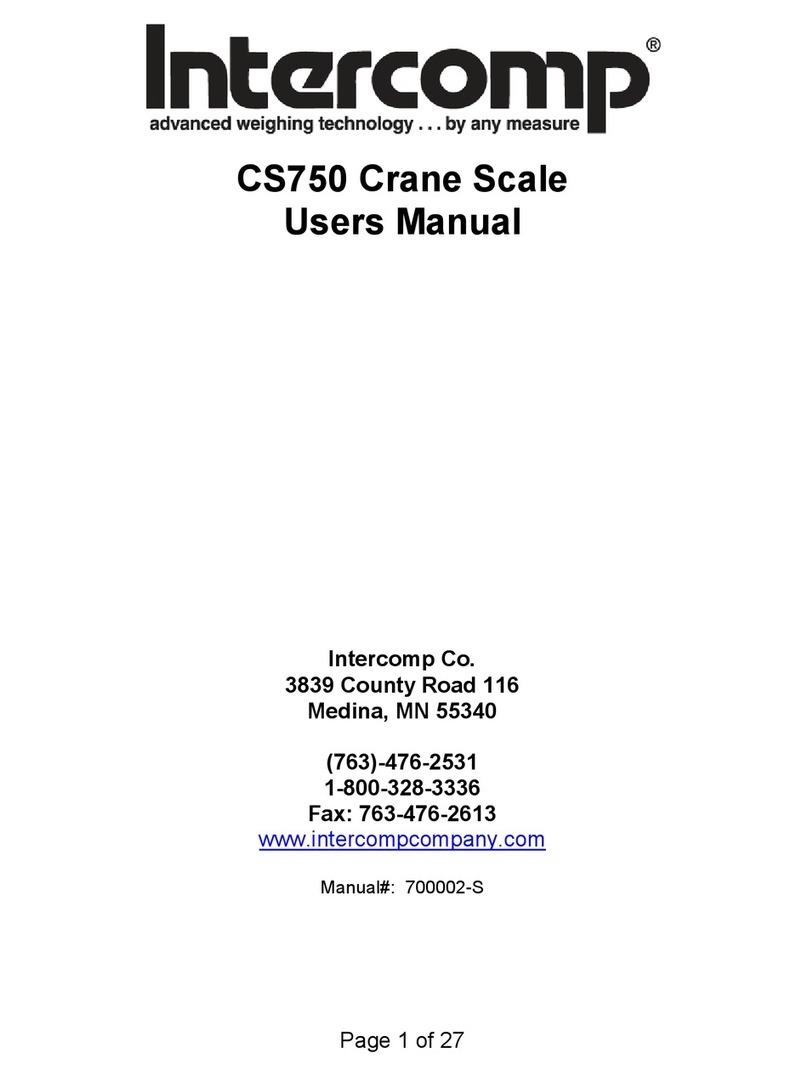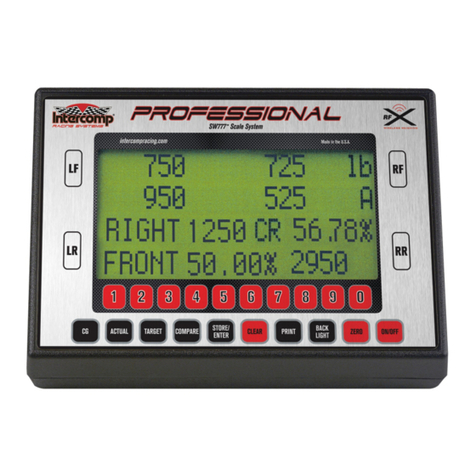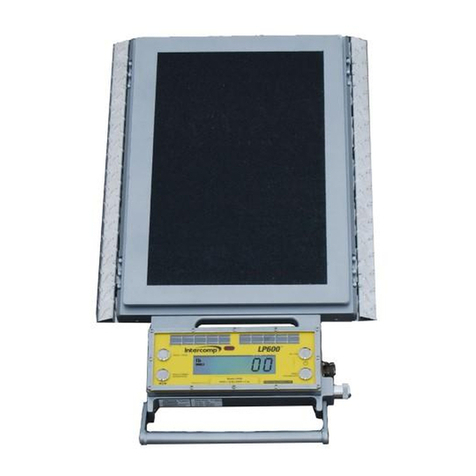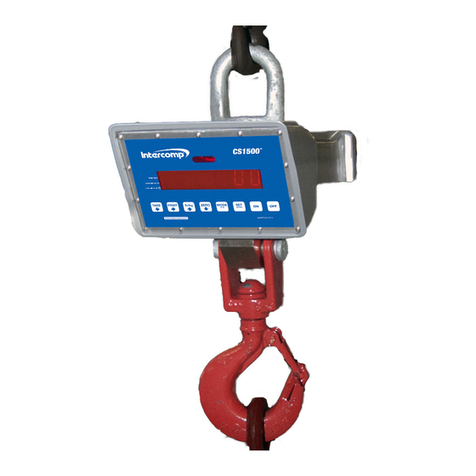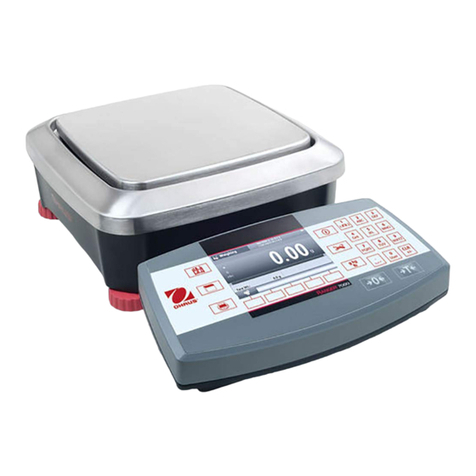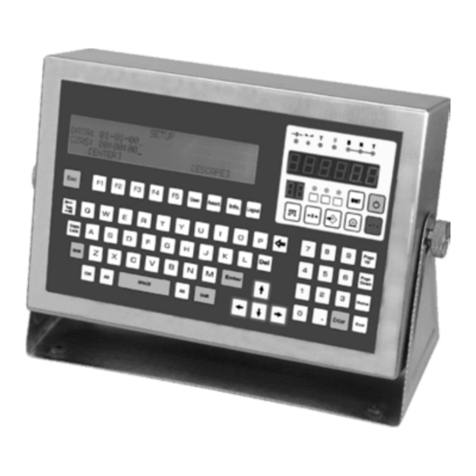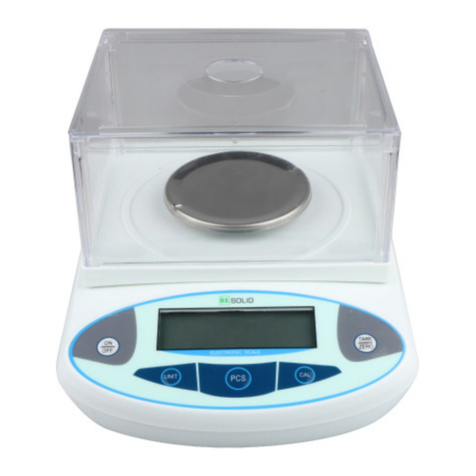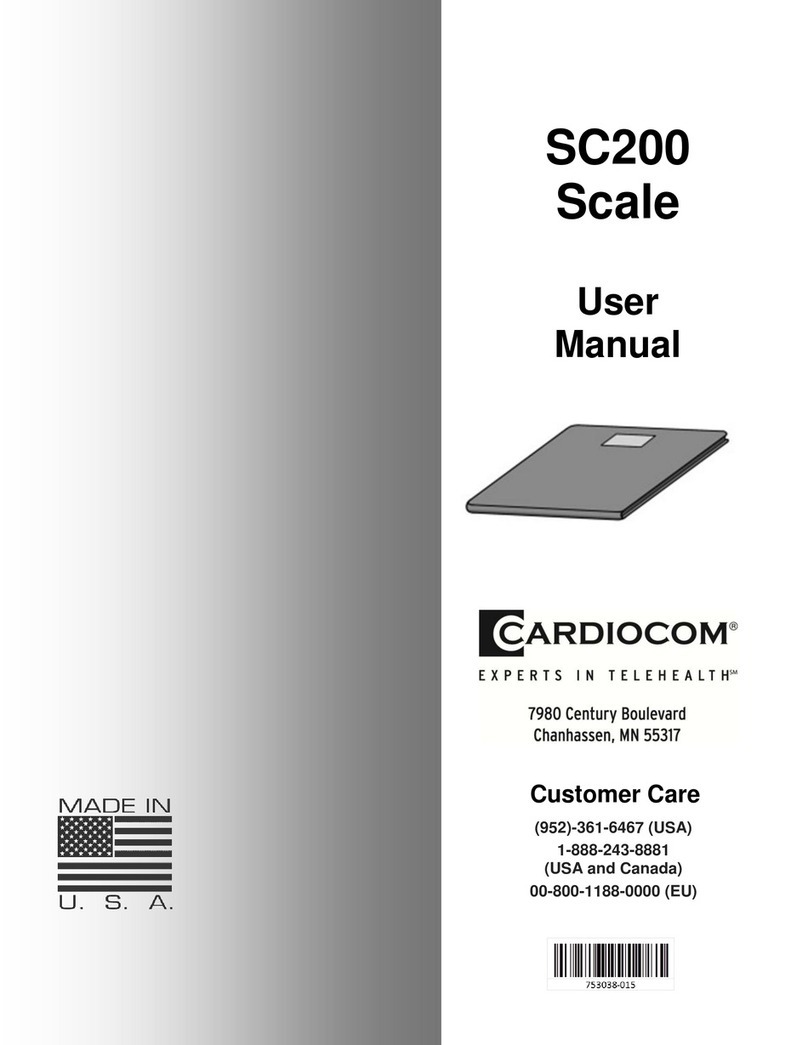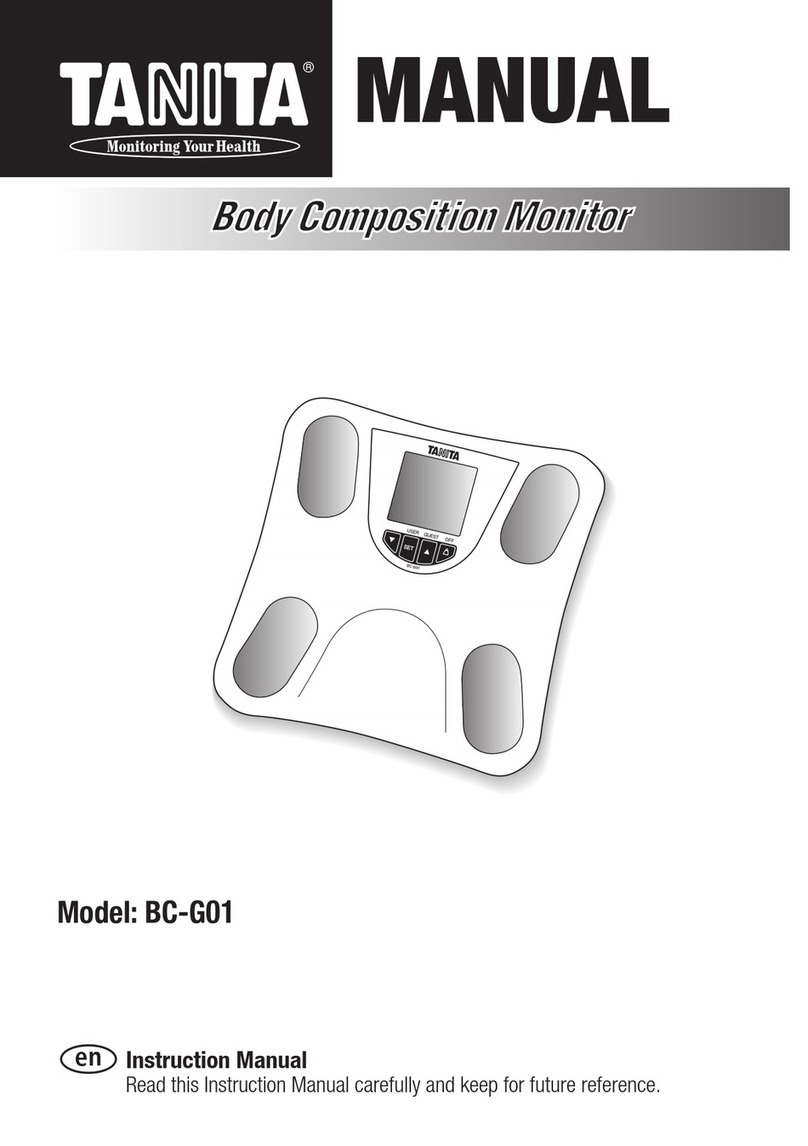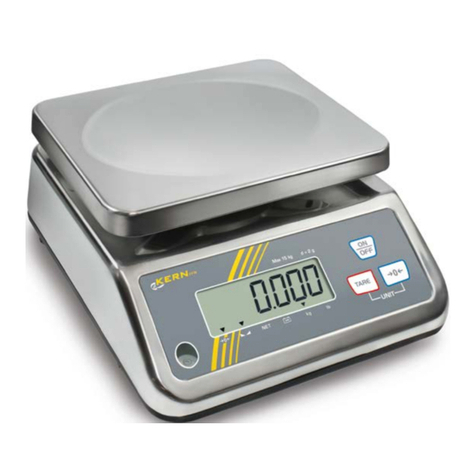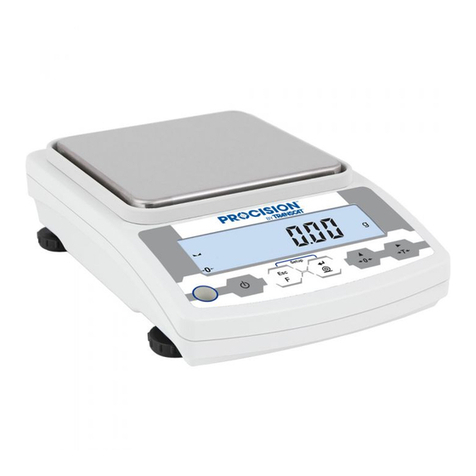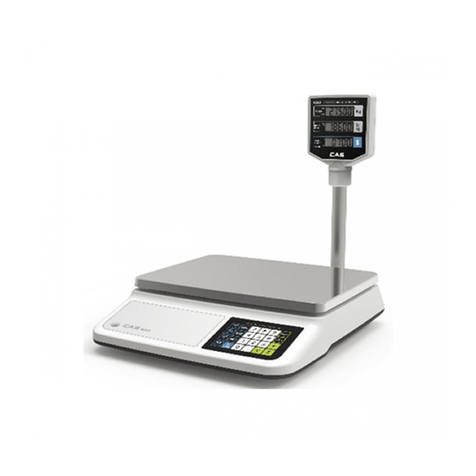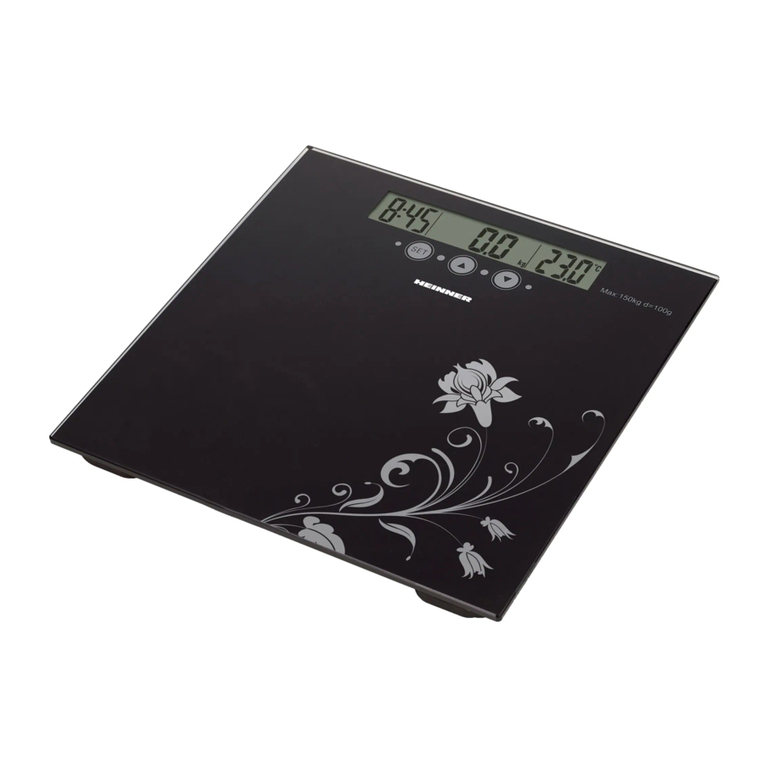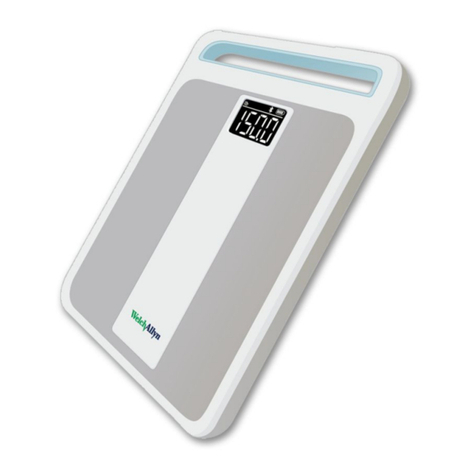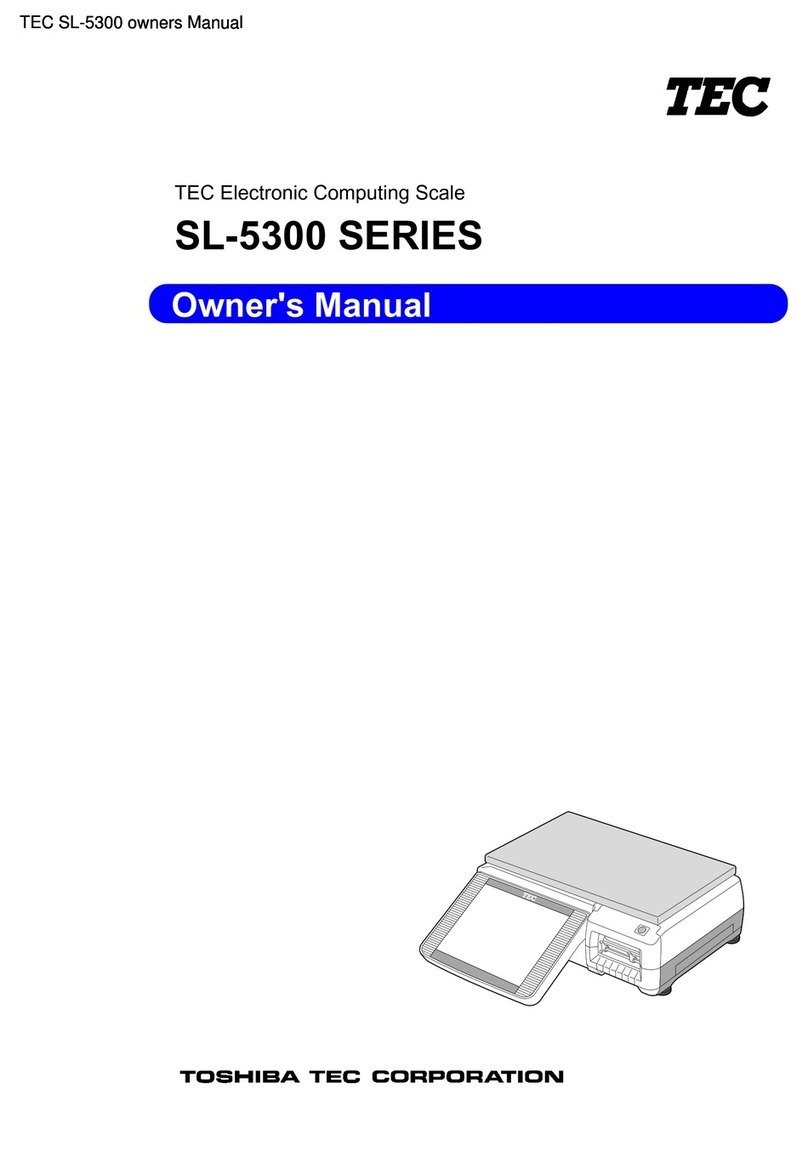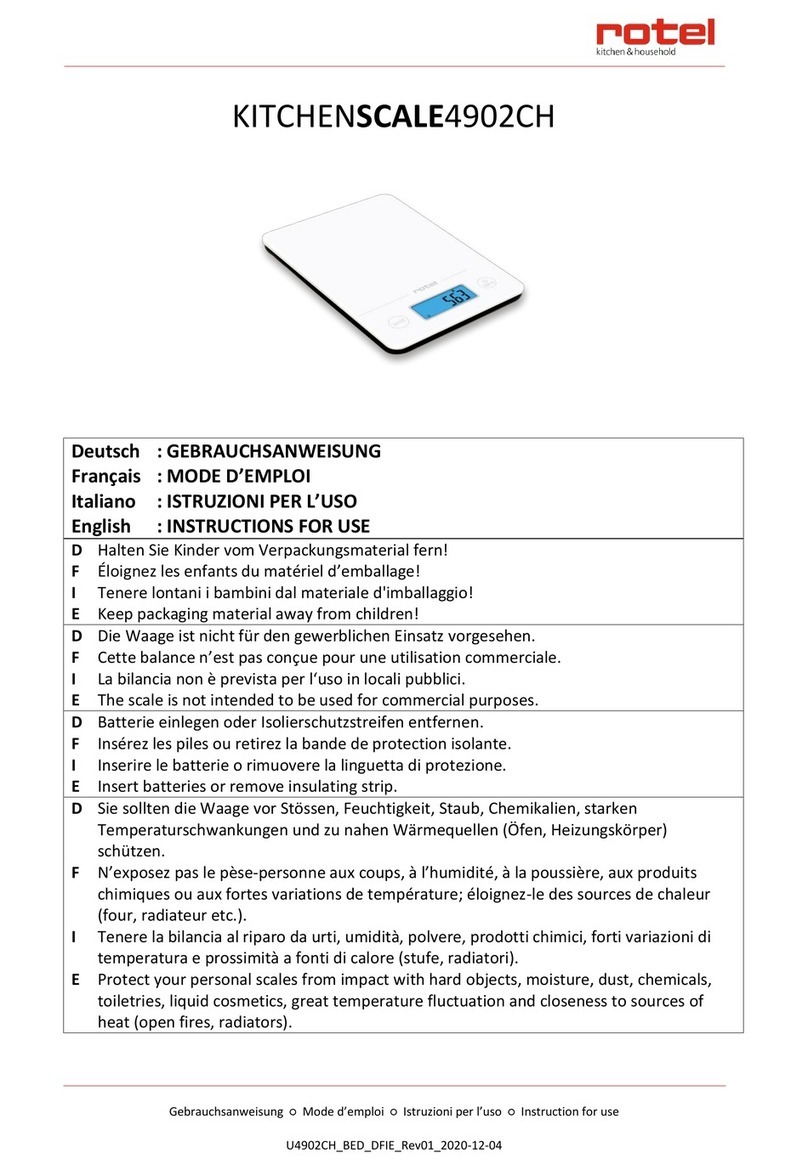Intercomp Tension Link TL6000 User manual

TL6000 Tension Link
Users Manual
Intercomp Co.
3839 County Road 116
Minneapolis MN 55340
(763)-476-2531
1-800-328-3336
Fax: 763-476-2613
http://www.intercompcompany.com/
Manual #: 700169-L

TL6000, U er
Rev L, June 2008
Page 2 of 22
Table of Content
INTRODUCTION .......................................................................................................................................................3
SPECIFICATIONS .........................................................................................................................................................3
Controls................................................................................................................................................................3
Electrical..............................................................................................................................................................3
Performance.........................................................................................................................................................3
Environmental......................................................................................................................................................3
Radio....................................................................................................................................................................4
OPERATIONS.............................................................................................................................................................5
OPERATING PRACTICES..............................................................................................................................................5
DISPLAY ....................................................................................................................................................................6
CONTROLS .................................................................................................................................................................7
ON/OFF ...............................................................................................................................................................7
MODE ..................................................................................................................................................................7
PRINT.................................................................................................................................................................................... 8
UNITS.................................................................................................................................................................................... 8
SET P1, SET P2, Audio Al rm (option l) ............................................................................................................................. 8
SAMPLE RATE .................................................................................................................................................................... 9
SLEEP ................................................................................................................................................................................... 9
AUTO OFF .......................................................................................................................................................................... 10
SERIAL DATA OUT........................................................................................................................................................... 10
BAUD RATE....................................................................................................................................................................... 10
ANALOG OUT.................................................................................................................................................................... 11
SCALE ID............................................................................................................................................................................ 11
ZERO..................................................................................................................................................................11
T RE..................................................................................................................................................................12
PE K..................................................................................................................................................................12
POWER/BATTERIES ..................................................................................................................................................12
MAINTENANCE.......................................................................................................................................................13
PERIODIC INSPECTION..............................................................................................................................................13
Service Categories .............................................................................................................................................13
Inspection Requirements ....................................................................................................................................13
Removal from Service Criteria...........................................................................................................................14
CALIBRATION...........................................................................................................................................................14
How to test the calibration.................................................................................................................................14
How to enter a number.......................................................................................................................................15
Calibration Strap ...............................................................................................................................................15
How to calibrate the scale..................................................................................................................................16
Calibrating the weight accuracy........................................................................................................................18
ERROR MESSAGES ................................................................................................................................................19
TROUBLESHOOTING ............................................................................................................................................19
SERIAL OUTPUT.....................................................................................................................................................20
SCOREBOARD ..........................................................................................................................................................21
HOW TO REACH INTERCOMP SERVICE.........................................................................................................22
"Thi document i the property of Intercomp Co. It contain material and
information that i confidential and protected under federal and/or tate trade
ecret, unfair competition, and copyright law. Any reproduction, u e or
di clo ure without written permi ion from Intercomp Co. i prohibited".

TL6000, U er
Rev L, June 2008
Page 3 of 22
Introduction
Thi manual contain pecification , operation in truction , and calibration in truction
for Intercomp' model TL6000 ten ion link.
Specifications
Controls
General: On/Off, Mode, Zero, Peak, Tare
Di play: 1.2” 5 digit LCD.
Indicator : 9 di play icon
Electrical
Batterie : 1 or 2 tandard or Ni-Cad 9V cell
Battery life: Standard: Approximately 800 hour battery life on 2 Alkaline
cell , 400 hour on 1 Alkaline cell.
Wirele ver ion: 50 hour / 25 hour .
Re olution: 14 bit A/D deliver over 16,000 internal count
Filtering: Analog and digital
Sleep mode: Operate in low-power mode after adju table time without u e
or motion.
Auto off: Low battery, or after adju table time without u e or motion.
Auto Zero: Selectable 1, 2, or 3 graduation
Output : RS232, RS485, 0V-2V analog, 2 Set Point (3.3V logic level)
Optional cabled or wirele connection to a TL6000 Remote.
Performance
Accuracy: For capacitie 500 lb – 10,000lb: ±0.1% of applied load or ± 1
divi ion, whichever i greater.
For capacitie 25,000 lb and higher: ±0.2% of applied load or
± 2 divi ion , whichever i greater.
Environmental
Humidity: 10 to 95% Non-Conden ing.
Temperature: Operating: -10 C to +40 C / +14 F to +104 F.
Storage: -40 C to +75 C / -40 F to +170 F.

TL6000, U er
Rev L, June 2008
Page 4 of 22
Radio
Radio frequency
(US/Canada)
902 -928 MHz, 100mW max output power, FHSS
Radio frequency (Europe) 869.7 - 870 MHz, 5mW max output power, FSK
Licen e requirement None. Pre-approved US/FCC, CAN/IC, EUR/EN
Range 200’ / 60m indoor, 400’ / 120m line of ight
WARNING: Thi equipment ha been approved for mobile application
where the equipment hould be u ed at di tance greater than 20cm from
the human body (with the exception of hand , wri t , feet, and ankle .
Operation at di tance le than 20cm i trictly prohibited.
!

TL6000, U er
Rev L, June 2008
Page 5 of 22
Operations
Note If u ing your cale with a TL6000 remote: For be t operation with the remote,
et the Rd Rate to [3] ( ee ection ‘
First four parameters
’) and Sleep to [0] ( ee
ection ‘SLEEP’) on the TL6000 cale.
Operating Practices
Warning: The crane cale will be operated by qualified de ignated per on , trainee
under the direct upervi ion of de ignated per on , maintenance and te t per onnel
when in performance of their a igned dutie , or lifting device in pector .
Warning: Do not exceed the rated load limit of the crane cale.
Warning: The crane cale hall be applied to the load in accordance with the
in truction manual.
Warning: Prior to lifting the operator hall make ure that all rope or chain are not
kinked and if multiple line are u ed they are not twi ted around each other.
Warning: En ure that the load i correctly di tributed for crane cale u e.
Warning: En ure the temperature of the load doe not exceed the maximum
temperature limit of the crane cale.
Warning: En ure that winging of the crane cale i minimized when po itioning it over
the load.
Warning: Avoid any udden acceleration of deceleration when moving the load.
Warning: Do not allow the crane cale or the lifter to come into contact with any
ob truction when moving the load.
Warning: Do not operate the crane cale if it ha damaged, malfunctioning or mi ing
part .
Warning: Do not lift people with the crane cale.
Warning: Do not lift u pended load over people.
Warning: Do not u e the crane cale to pull ide load or to lide load unle
pecifically authorized by a qualified per on.
Warning: Do not leave u pended load unattended.

TL6000, U er
Rev L, June 2008
Page 6 of 22
Warning: Do not remove or ob cure warning label .
Warning: Do not operate the crane cale without having read and under tood the
operating manual.
Warning: Stay clear of u pended load .
Warning: Do not lift load higher than nece ary.
Warning: Do not make alteration or modification to the crane cale.
Warning: En ure all portion of the human body are kept clear of all device involved
with the rigging during the lift.
Display

TL6000, U er
Rev L, June 2008
Page 7 of 22
Controls
ON/OFF
Pre thi key to turn the cale on. The cale te t it elf; when the e te t have
completed ucce fully, the y tem begin weighing. Pre thi key to turn the
cale off.
MODE
Many of the internal parameter can be adju ted through the mode function.
There are a total of 12 mode : Backlight, Print, Unit , Set P1, Set P2, Sample
Rate, Sleep, Auto-off, Serial data output, Baud rate, Analog output, Scale ID.
Mode Description Notes Default
Print
PrintPrint
Print
Print ticket Hold MODE to print -
UnitS
UnitSUnitS
UnitS
Unit of weight lb, kg, daN, N, ton, kg x 1000 lb
SEtP1
SEtP1SEtP1
SEtP1
Set point 1 0 to 99999 99999
SEtP2
SEtP2SEtP2
SEtP2
Set point 2 0 to 99999 99999
S rt
S rtS rt
S rt
Sample rate 1 to 100 5
SLEEP
SLEEP SLEEP
SLEEP
Sleep mode 1 to 180 (min.) 0 = di able 5
AOFF
AOFFAOFF
AOFF
Auto off 1 to 180 (min.) 0 = di able 60
S Out
S OutS Out
S Out
Serial data out 0 = print (on-demand)
1 = continuou
3 = fa t continuou (variable)
0
Baud
BaudBaud
Baud
baud rate 300,600,1200,2400,4800,9600 9600
A OUT
A OUTA OUT
A OUT
analog out 0 = di able, 1 = enable 0
SC Id
SC IdSC Id
SC Id
cale ID 1 to 20 1

TL6000, U er
Rev L, June 2008
Page 8 of 22
Pre the MODE key to equentially toggle through the mode . To edit a mode
pre and hold the MODE key until the di play change . The value can be
changed by u ing the arrow keys:
↑ MODE
↓ TARE
← PEAK
→ ZERO
Plea e ee the information below for pecific in truction on editing each mode.
To ave the information you edited, pre and hold the MODE key until the
di play read ‘Save’. The TL6000 will then return to normal mea urement mode.
PRINT
Thi feature allow the net weight to be printed. See “Serial Output”
ection for more information.
To print ticket:
Press the MODE key until the display reads “Print
PrintPrint
Print”. Press and hold the
MODE key until the display reads “Print
PrintPrint
Print” again. The net weight will be
printed and the re ote returns to nor al operating ode.
UNITS
Mea urement can be taken in 6 different unit : lb (pound), kg (kilogram),
daN (DakaNewton), N (Newton), ton (Engli h ton), kg x1000 (Metric ton).
Changing Unit
Pre the mode key twice until the di play read ‘Units
UnitsUnits
Units’. Pre and hold
the MODE key until it read ‘Uedit
UeditUedit
Uedit’. Pre the left and right key (PEAK
and ZERO) to toggle through the unit of mea urement. The current unit
i di played on the bottom of the LCD. To ave the unit you want to
operate in pre and hold the MODE key until it read ‘Save
SaveSave
Save’. The TL6000
will return to mea urement mode.
Notes: If you change the units while a tare is set, the tare will be erased.
Changing units can affect the set points. If you are using the set
points, be sure to check the after changing units.
SET P1 SET P2 Audio Alarm (optional)
When the weight di played i equal to or greater than the et point, the
corre ponding indicator i di played on the LCD. The et point indicator
are the ‘S1’ and ‘S2’ icon located at the lower left corner of the di play.
Changing unit can affect the et point . If you are u ing the et point ,
be ure to re- et them after changing unit . There are et point output
ignal which can be utilized by u ing the connector located on the ide of
the TL6000. When Set Point #1 i reached, a logic ‘high’ will be pre ent
on pin 1 of the connector. When Set Point #2 i reached, a logic ‘high’ will
be pre ent on pin 2 of the connector.

TL6000, U er
Rev L, June 2008
Page 9 of 22
Note: If your scale has the optional audio alar , Set Point #1 and #2 are
not wired to the external connector. Instead, Set point #1 controls when
the alar will sound. The alar will sound whenever the weight applied to
the scale is greater than or equal to the weight entered into “Set P1”.
Changing Set Point
Pre the MODE button three time until the di play read ‘SEtP1
SEtP1SEtP1
SEtP1’. Pre
and hold the mode button until it read ‘Edit
EditEdit
Edit’. Change the value by u ing
the up/down, left/right (MODE/TARE, PEAK/ZERO) button . To ave the
et point pre and hold the MODE button until it read ‘SAvE
SAvESAvE
SAvE’. The
TL6000 will return to mea urement mode. To change Set Point 2, pre
the MODE button four time , until the di play read ‘SEtP2
SEtP2SEtP2
SEtP2’ and follow the
ame in truction a above in truction .
Default = 99999.
SAMPLE RATE
The higher the ample rate, the more averaging of pa t reading the
ten ion link u e to compute the di played weight. ‘1’ re ult in the
fa te t update time , while ‘100’ give you the mo t table read-out .
Changing the Sample rate:
Pre the MODE key five time until the di play read ‘S rt
S rtS rt
S rt ’. Pre and
hold the MODE key until the di play read ‘Edit
EditEdit
Edit’. Change the value by
u ing the arrow key . To ave the new ample rate pre and hold
MODE until the di play read ‘Save
SaveSave
Save’. The TL6000 will return to
mea urement mode.
Default = 5.
SLEEP
The TL6000 feature a low-power mode to con erve battery power. If the
cale doe not experience any activity for a predetermined amount of
minute , the y tem will witch to low -power mode. When in low power
mode, the cale till operate normally. The only difference i a lowed
re pon e rate. You may have to wait a econd or two for a change in
weight to how up on the di play. Any key pre ed or change in weight
will return the cale to normal mode.
Adju ting Sleep:
Pre the MODE key ix time until the di play read ‘SLEEP
SLEEPSLEEP
SLEEP’. Pre and
hold the MODE key until the di play read ‘Edit
EditEdit
Edit’. Change the value (in
minute ) u ing the arrow key . Any entry from 1 to 180 minute i
allowed. To di able the leep feature enter 0. To ave your data pre
and hold the MODE key until the di play read ‘Save
SaveSave
Save’. The y tem will
return to mea urement mode.
Default = 5.

TL6000, U er
Rev L, June 2008
Page 10 of 22
AUTO OFF
The TL6000 will automatically hut off if it doe not experience any
change in weight or key pre ed for a u er et amount of time.
Adju ting Auto Off:
Pre the MODE key even time until the di play read ‘AOFF
AOFFAOFF
AOFF’. Pre
and hold the MODE key until the di play read ‘Edit
EditEdit
Edit’. Change the value
(the unit i in minute ) u ing the arrow key . Any entry from 1 to 180
minute i allowed. To di able the auto off feature enter 0. To ave your
data, pre and hold the MODE key until the di play read ‘Save
SaveSave
Save’. The
y tem will return to mea urement mode.
Default = 60.
SERIAL DATA OUT
The TL6000 ha a RS232 and a RS485 output o the cale may be
connected to a printer, computer or other external device. See “Serial
Output” ection for more information.
Note: Serial data does not trans it during sleep ode.
Enabling/Di abling Serial data out:
Pre the MODE key until the di play read ‘S Out
S OutS Out
S Out ’. Pre and hold the
MODE key until the di play read ‘Edit
EditEdit
Edit’. Change the value u ing the
arrow key . “on-demand print” mean there will only be output when the
u er pre e print ( ee ‘PRINT’ ection for detail ). When et to
“continuou ”, there will be a continuou erial output at a rate of about 1
weight tran mi ion/ econd. When et to “fa t continuou (variable)”, the
tran mi ion rate can be much fa ter, varying from about 1 to 13 weight
tran mi ion / econd. In thi mode the rate varie depending on your
etting of “Read Rate” and “Baud Rate”. For the fa te t tran mi ion
rate et Read Rate=7 ( ee calibration ection) and Baud Rate = 9600
( ee below). Warning: In “fa t continuou ” mode, the unit’ di play will
update a fa t a it print . At the highe t etting thi can re ult in the
di play changing o fa t that it i ometime difficult to read.
On-demand print 0
continuou 1
fa t continuou (variable) 3
To ave your data, pre and hold the MODE key until the di play read
‘Save
SaveSave
Save’. The y tem will return to mea urement mode.
BAUD RATE
The baud rate i the frequency at which the erial data output i ent.
Operational baud rate : 300, 600, 1200, 2400, 4800, 9600.

TL6000, U er
Rev L, June 2008
Page 11 of 22
The default value for the baud rate i 9600 baud (bit / ec). Thi etting
only affect the printer output.
Changing the baud rate:
Pre the MODE key nine time until the di play read ‘b rt
b rtb rt
b rt ’. Pre and
hold the MODE key until the di play read ‘Edit
EditEdit
Edit’. Change the value u ing
the arrow key . To ave your data, pre and hold the MODE key until
the di play read ‘Save
SaveSave
Save’. The y tem will return to mea urement mode.
ANALOG OUT
Thi optional feature allow a 0V to 2V analog voltage that i panned
linearly by the applied weight to the ten ion link. The capacity the u er
et equal the maximum voltage level (2.0V) and no weight applied
equal 0V. All other voltage level will be linear (ratio metric) with the
weight value. For example, if the applied weight i ½ the capacity, the
voltage will be 1.0V. The analog output i utilized by the connector on the
ide of the cale.
Enabling or Di abling analog output
Pre the mode key ten time until the di play read “A Out
A OutA Out
A Out”. Pre and
hold the MODE key until the di play read ‘Edit
EditEdit
Edit’. Pre the up and down
key to change the etting. ‘1’ enable the analog out and ‘0’ di able the
analog out. To ave your data, pre and hold the MODE key until the
di play read ‘Sav
SavSav
Save
ee
e’. The y tem will return to mea urement mode.
Enable 1
Di able 0
SCALE ID
The cale ID parameter i u ed when you have a wirele TL6000
y tem. Each TL6000 cale mu t have a different cale ID (1 to 20).
Changing the cale ID:
Pre the MODE key until the di play read ‘SC Id
SC IdSC Id
SC Id ’. Pre and hold the
MODE key until the di play read ‘Edit
EditEdit
Edit’. Change the value u ing the
arrow key . To ave your data, pre and hold the MODE key until the
di play read ‘Save
SaveSave
Save’. The y tem will return to mea urement mode.
ZERO
Tell the cale to di play a zero weight. Thi key i u ed any time the cale
how a non-zero value with no weight on the cale. If you pre ZERO with
weight on the hook, that weight become the zero condition for the cale. Thi
can be u eful to cancel the weight of chain or cable . When thi weight i
removed, a negative weight how until the y tem i zeroed again.
The zero point i aved into memory. Thi mean you can turn the cale off and

TL6000, U er
Rev L, June 2008
Page 12 of 22
on with weight applied, o that the di played weight i the actual gro weight.
The cale contain a feature called Auto Zero Tracking (AZT), which correct
for light zero change during normal operation. If the AZT i enabled and mall
weight are added lowly, the cale could zero them off.
TARE
Pre ing the TARE key will et the tare equal to the current gro weight and
witch the di play to net weight. The di play will read ‘nEt
nEtnEt
nEt’ when the TARE
button i relea ed. The net weight i equal to the gro weight minu the tare
weight. The tare weight will only be et if the current gro weight i po itive.
Displaying the tare weight:
If a tare weight i et, pre ing the TARE key will di play the current value
of the tare. The tare will be di played a long a you hold the key.
Clearing the tare:
Pre ing the ZERO and TARE key together will re et the tare to zero.
The di play will read ‘GroSS
GroSSGroSS
GroSS’ when the key are relea ed. Thi ignifie
that the cale will now di play gro weight, which i equal to the net
weight when tare = 0.
PEAK
The peak hold feature will remember the maximum weight applied. While in peak
mode it will not di play any weight le than the maximum weight. To turn on the
peak mode pre PEAK, to turn off the peak mode pre PEAK again. To clear
the peak weight, pre the ZERO key.
Note: When you turn off the peak ode, the current peak weight will still be
re e bered internally. This will show up if you then turn the peak ode back
on. Press ZERO (or turn the scale off) to clear the peak weight.
Power/Batteries
Remove the two crew on the ide of the unit (either ide). Replace the 9V battery.
Replace the cover.
You may u e rechargeable Nickel-Cadmium 9V cell or tandard alkaline 9V cell in the
TL6000. Note: Only one 9V battery i required to run the TL6000. The econd 9V
battery will double the ob erved battery life.
The typical recharge time for Ni-cad cell i 16 hour . The rechargeable batterie have
a life pan up to 1000 cycle .

TL6000, U er
Rev L, June 2008
Page 13 of 22
Maintenance
Periodic Inspection
The crane cale and all a ociated adaptive device require periodic in pection and
maintenance. The frequency and recording of the in pection requirement are found in
ervice categorie below and are dependant on the type of ervice that the equipment
i u ed in a de cribed below.
Service Categories
Normal Service – Crane cale i operated at le than 85% of it’ capacity except for
i olated in tance . Complete the frequent ervice in pection monthly and record the
periodic ervice in pection annually.
Heavy Service – Crane cale i operated at 85% - 100% of it’ capacity a part of
normal u age. Complete the frequent ervice in pection weekly to monthly and record
the periodic ervice in pection emi-annually.
Severe Service – Crane cale i operated at 85% - 100% of it’ capacity and u ed in
environmental condition that are unfavorable, harmful or detrimental to the u e of the
crane cale. Complete the frequent ervice in pection daily to weekly and record the
periodic ervice in pection quarterly.
Inspection Requirements
Frequent Service Inspection (record not required)
A frequent vi ual in pection i completed at interval indicated by the ervice category
above by the operator or de ignated per on of the following.
1. In pect for tructural deformation, crack or exce ive wear of any part of the
crane cale or a ociated adaptive device .
2. In pect for loo e or mi ing guard , fa tener , cover , top , or nameplate .
3. In pect all functional operating mechani m and automatic hold and relea e
mechani m for improper adju tment interfering with operation of the crane
cale or a ociated adaptive device .
4. In pect for di tortion uch a bending, twi ting, or increa ed throat opening (if
applicable)
Periodic Service Inspection (record required)
A periodic vi ual in pection i completed at interval indicated by the ervice category
above by the operator or de ignated per on and documented to provide the ba i for
continuing evaluation. The periodic in pection will cover area in the frequent ervice
in pection above and the following.
1. In pect for loo e bolt or fa tener .
2. In pect for cracked or worn gear , pulley , heave , procket , bearing , chain ,
and belt .
3. In pect for exce ive wear of linkage and other mechanical part .

TL6000, U er
Rev L, June 2008
Page 14 of 22
4. In pect for exce ive wear at hoi t hooking point and load upport clevice or
pin .
5. In pect for any vi ible bend or twi t of all u ed rigging device .
6. In pect all latche and lock for proper operation (if applicable)
Removal from Service Criteria
Note: Replacement part of any device or part of any device u ed in any a pect of
rigging to lift a load hall be at lea t equal to the original manufacture’ pecification
Hooks
Hook hall be removed from ervice if damage uch a the following i found and hall
only be returned to ervice if a qualified per on approve their continued u e and
initiate corrective action.
1. Hook how crack , nick , or gouge .
2. Hook ha wear exceeding 10% of the original ectional dimen ion.
3. Hook ha any vi ible bend or twi t from the plane of the unbent hook.
4. Hook ha an increa e in throat opening of 5% not to exceed ¼ of an inch.
5. If elf-locking hook have the inability to lock.
6. A hook latch that i inoperable (if applicable)
Shackles
Shackle hall be removed from ervice if damage uch a the following i vi ible and
hall only be returned to ervice when approved by a qualified per on.
1. If the manufacturer name or trademark and / or the rated load identification i
mi ing or illegible.
2. The device how ign of heat damage including weld patter or arc trike .
3. The device how exce ive pitting or corro ion.
4. The device i bent, twi ted, di torted, tretched, elongated, cracked, or ha
broken load-bearing component .
5. The device ha exce ive nick or gouge .
6. The device ha a 10% reduction of the original or catalog dimen ion at any point
around the body or pin.
7. The device ha incomplete pin engagement.
8. The device ha exce ive thread damage.
9. The device how evidence of unauthorized welding.
10. Any other condition including vi ible damage that cau e doubt to the continued
u e of the hackle.
Calibration
How to test the calibration
Thi calibration procedure hould be performed annually for normal operating
condition . If the cale i dropped or damaged, or ervice ha been performed on the
cale, u e thi calibration check. Recommend weight from 10% through 100% of cale
capacity in 10% increment .

TL6000, U er
Rev L, June 2008
Page 15 of 22
1. Pre the ON witch. The di play doe a lamp te t; during thi time the cale doe a
quick check of it elf. Then the weighing y tem tart weigh mode.
2. Intercomp recommend that you allow the electronic to operate for three minute
after fir t turning the power on. Thi allow the electronic to become table for
maximum accuracy before you check the calibration .
3. Make ure no weight i on the hook. Pre the ZERO key. Pre the TARE and
ZERO key to clear tare. The weight hown i zero.
4. Apply weight throughout the weighing range, and verify the correct weight i
di played at each tep. (+/- 0.1% of applied load or ± 1 divi ion, whichever i greater
for cale 500 – 10000 lb and ±0.2% of applied load or ± 2 divi ion , whichever i
greater for cale 25000 lb or greater)
5. Remove weight and verify the di play return to zero.
6. If there i a failure to meet any of the condition above, plea e refer to the
Calibration Procedure.
7. When all the condition above are correct, the cale i operational.
How to enter a number
During thi routine you will be a ked to enter number at many point . The cale will
how a number (originally all zero ) with a blinking digit. At thi point the command li ted
at the ide of the key become active. Pre the UP and DOWN arrow key to increa e
and decrea e the blinking digit. Pre the LEFT and RIGHT arrow key to move to other
digit . Pre the ZERO and PEAK key together to ave the value and advance to the
next parameter.
Five point span
The cale ha a five point calibration feature that reduce the effect of non-linearity in
the load cell . Thi require that you place five weight on the cell during calibration.
The fir t weight mu t be greater than zero, the econd greater than the fir t, the third
greater than the econd, the fourth greater than the third, and the final weight
omewhere between the fourth and the capacity. To u e le than five calibration
point , turn the cale off before reading the next cal point.
Calibration Strap
The calibration header that u e the calibration horting trap i located on the bottom
ide of the circuit board (oppo ite ide of the di play). Thi 90° header i labeled CAL.
Enabling the calibration.
The fir t four parameter may be edited with or without the calibration trap. To
perform the actual weight calibration, you mu t remove the calibration blocking
trap. Remove the 4 crew on the back plate of the ten ion link. Remove back
plate. The calibration header i located on the lower right corner of the circuit
board. Remove the black horting trap and lide it on one of the pin (for
convenience). Screw the back plate back on.

TL6000, U er
Rev L, June 2008
Page 16 of 22
How to calibrate the scale
The following detail the calibration procedure for the ten ion cale. All parameter can
be et without the calibration trap. If the cal trap i in place, only the fir t four
parameter may be calibrated.
Step Function Note
Default
rd rt
rd rtrd rt
rd rt
Read Rate 1 to 7 ( ee table) 4
Azt
AztAzt
Azt
Auto Zero Tracking 0=off, 1=1, 2=2, 3=3 3
GrAd
GrAdGrAd
GrAd
Graduation 0 to 12 ( ee table) 6
CAP
CAPCAP
CAP
Capacity Enter Capacity
Information aved
Check Cal Strap
LOAd0
LOAd0LOAd0
LOAd0
Zero Read No weight applied
LOAd1
LOAd1LOAd1
LOAd1
Fir t weight Enter fir t weight
LOAd2
LOAd2LOAd2
LOAd2
Second weight Enter econd weight
LOAd3
LOAd3LOAd3
LOAd3
Third weight Enter third weight
LOAd
LOAdLOAd
LOAd
Fourth weight Enter fourth weight
LOAd5
LOAd5LOAd5
LOAd5
Fifth weight Enter fifth weight
Start up
Note: Read section titled: How to enter a nu ber
1) Turn cale power ON.
2) Wait for cale to warm up (3 minute from power on).
3) Pre ZERO and PEAK together and relea e to enter the calibration mode.
First four parameters
4) The cale how ‘rd rt
rd rtrd rt
rd rt ’. The read rate i the number of internal read per
econd the cale perform . A higher etting will re ult in a fa ter re ponding
cale, but will al o u e the battery life more quickly. Pre ZERO and PEAK
together to edit the read rate. Enter the read rate (1 to 7).
Note: When you plan to connect the TL6000 to a cabled or wireless TL6000
re ote, set the read rate to (3) or less for best results.
Read Rate Readings / sec
1 1
2 2
3 4
4 7
5 10
6 18
7 25

TL6000, U er
Rev L, June 2008
Page 17 of 22
Note: If the “Serial Out” etting in your unit i et to “3 = fa t continuou ” then
the above read rate will be lower becau e of the time the cale pend
tran mitting data out the erial port.
5) The cale how ‘AZt
AZtAZt
AZt ’. Pre ZERO and PEAK together to edit the Auto
Zero Tracking. Enter the AZT ize (0 to 3 divi ion ). AZT i the number of
graduation the auto zero tracking can remove. An entry of ‘0’ di able the
feature.
6) The cale how ‘GrAd
GrAdGrAd
GrAd’. Pre ZERO and PEAK together to edit the
Graduation . U e the following table to elect and enter a graduation value.
Graduations and Units
Grad Setting
lb Kg N daN ton kg x 1000
0 100 50 100 50 0.05 0.05
1 50 20 100 20 0.02 0.02
2 20 10 100 10 0.01 0.01
3 10 5 50 5 0.005 0.005
4 5 2 20 2 0.002 0.002
5 2 1 10 1 0.001 0.001
6 1 0.5 5 0.5 0.0005 0.0005
7 0.5 0.2 2 0.2 0.0002 0.0002
8 0.2 0.1 1 0.1 0.0001 0.0001
9 0.1 0.05 0.5 0.05
10 0.05 0.02 0.2 0.02
11 0.02 0.01 0.1 0.01
12 0.01 0.005
0.05 0.005
Note: Grads 9-12 do not exist for ton and kg x1000.
NOTE: The tated accuracy pecification are ba ed on the graduation etting in
the table below. If the graduation etting i et other than the value in the table
below the accuracy pecification remain with the graduation ize li ted below.
If your capacity is: Set your graduation to:
1000 lb / 500 kg 1 lb / 0.5 kg (6)
2000 lb / 1000 kg 2 lb / 1 kg (5)
5,000 lb / 2,500 kg 5 lb / 2 kg (4)
10,000 lb / 5,000 kg 10 lb / 5 kg (3)
25,000 lb / 12,500 kg 20 lb / 10 kg (2)
50,000 lb / 25,000 kg 50 lb / 20 kg (1)
100,000 lb / 50,000 kg 100 lb / 50 kg (0)
7) The cale how ‘CAP
CAPCAP
CAP’. Pre ZERO and PEAK together to edit the Capacity.
Enter the capacity. Pre the ZERO and PEAK key together to ave the
data and the di play will read ‘SAvE
SAvESAvE
SAvE’.

TL6000, U er
Rev L, June 2008
Page 18 of 22
Calibrating the weight accuracy
Note: At this ti e the scale saves any changes that have been ade.
Note: A check is then ade to see whether or not the calibration blocking strap
is in place. If the blocking strap is in place, the scale shows ‘CALSt
CALStCALSt
CALSt’ for a few
seconds and then returns to nor al weighing.
8) A uming the calibration trap wa removed, the di play will read ‘L0Ad0
L0Ad0L0Ad0
L0Ad0’.
With no weight applied to the cale, pre ZERO and PEAK together.
9) The di play will read ‘L0Ad1
L0Ad1L0Ad1
L0Ad1’. Apply the fir t weight. When the weight i
table pre one of the arrow key . The di play will read ‘H0Ld
H0LdH0Ld
H0Ld’ while the
cale acquire the fir t weight. After thi , enter the value of the applied
weight. Pre ZERO and PEAK together to ave the value and advance to
Load 2.
10) The di play will read ‘L0ad2
L0ad2L0ad2
L0ad2’. Apply the econd weight. When the weight i
table pre one of the arrow key . The di play will read ‘H0Ld
H0LdH0Ld
H0Ld’ while the
cale acquire the econd weight. After thi , enter the value of the applied
weight. Pre ZERO and PEAK together to ave the value and advance to
Load 3.
11) The di play will read ‘L0Ad3
L0Ad3L0Ad3
L0Ad3’. Apply the third weight. When the weight i
table pre one of the arrow key . The di play will read ‘H0Ld
H0LdH0Ld
H0Ld’ while the
cale acquire the third weight. After thi , enter the value of the applied
weight. Pre ZERO and PEAK together to ave the value. The di play will
read ‘SAvE
SAvESAvE
SAvE’ for a few econd and advance to Load 4.
12) The di play will read ‘L0Ad
L0AdL0Ad
L0Ad ’. Apply the fourth weight. When the weight i
table pre one of the arrow key . The di play will read ‘H0Ld
H0LdH0Ld
H0Ld’ while the
cale acquire the third weight. After thi , enter the value of the applied
weight. Pre ZERO and PEAK together to ave the value. The di play will
read ‘SAvE
SAvESAvE
SAvE’ for a few econd and advance to Load 5.
13) The di play will read ‘L0Ad5
L0Ad5L0Ad5
L0Ad5’. Apply the fifth weight. When the weight i
table pre one of the arrow key . The di play will read ‘H0Ld
H0LdH0Ld
H0Ld’ while the
cale acquire the third weight. After thi , enter the value of the applied
weight. Pre ZERO and PEAK together to ave the value. The di play will
read ‘SAvE
SAvESAvE
SAvE’ for a few econd and return to mea urement mode.
14) Verify calibration.
15) Replace the cal trap to protect again t accidental entry into the calibration
routine in the future.
16) Calibration complete.

TL6000, U er
Rev L, June 2008
Page 19 of 22
Error Messages
OvER
OvEROvER
OvER
The cale i over capacity. Reduce the weight applied to the cale.
OE
OEOE
OE
The cale i out ide the internal A/D converter range. Reduce the weight
applied to the cale.
dISP
dISPdISP
dISP
Di play error. Value i too large to fit on the di play. Reduce the weight
applied to the cale, or try changing graduation .
-dISP
-dISP-dISP
-dISP
Di play error. Value i too negative to fit on the di play. Pre ZERO to
zero the cale.
EEPE
EEPEEEPE
EEPE
EEPROM error. The cale ha had it’ calibration corrupted or de troyed;
the cale will require calibration.
Err 1
Err 1Err 1
Err 1
Error during calibration. The cale automatically exit calibration mode.
When calibrating, make ure that each of the three calibration weight i
larger than the previou weight.
Err 2
Err 2Err 2
Err 2
EEPROM error. The cale i unable to read the EEPROM.
Err
Err Err
Err
EEPROM error. The cale i unable to write to the EEPROM.
CALSt
CALStCALSt
CALSt
Thi me age will how for a few econd if you have attempted to acce
weight calibration with the calibration trap in place. See the “Calibration”
ection if you need to calibrate.
Troubleshooting
Problem: Solution:
Di play freeze or i blank and no
re pon e to key pre ed
The MCU may have locked up. Try
removing both batterie together, and then
replacing one or both of them. A a
general rule to reduce lock-up , whenever
turning the TL6000 off, wait at lea t 5-10
econd before turning it on again.
Batterie are good but the cale won’t
power up.
If the cale i turned off and turned back
on right away, the cale may not be able to
power up. Wait about 10 econd after
powering off before pre ing the ON key
again.

TL6000, U er
Rev L, June 2008
Page 20 of 22
Serial Output
The TL6000 can be et to output (continuou ) to a coreboard or other external device
u ing RS232 or RS485 format . See mode menu / erial data out. The TL6000 can
al o tran mit and receive RS232 ignal (continuou ) to communicate with a Ten ion
Link remote. The TL6000 can al o be et to output (on demand) to a printer.
The ignal come out of the 8-pin Serial I/O connector located on the right ide of the
unit. The connector ha the following pinout:
Signal Pin
RS232-TXD1 (remote) 3
RS232-TXD2 (printer/ coreboard) 4
RS232-RXD 5
GND 6
RS485-A (printer/ coreboard) 7
RS485-B (printer/ coreboard) 8
Set Point #1 (3.3V logic level) 1
Set Point #2 (3.3V logic level) 2
NOTE: If your scale has the wireless option, pins 3 & 5 will be unconnected internally.
The tran mitted erial data ha the following characteri tic :
Fixed 8 Data bit , no parity, 1 top bit.
Baud rate i configurable. See Mode ection.
The RS232 output wing from -6 VDC to 6 VDC.
Table of contents
Other Intercomp Scale manuals
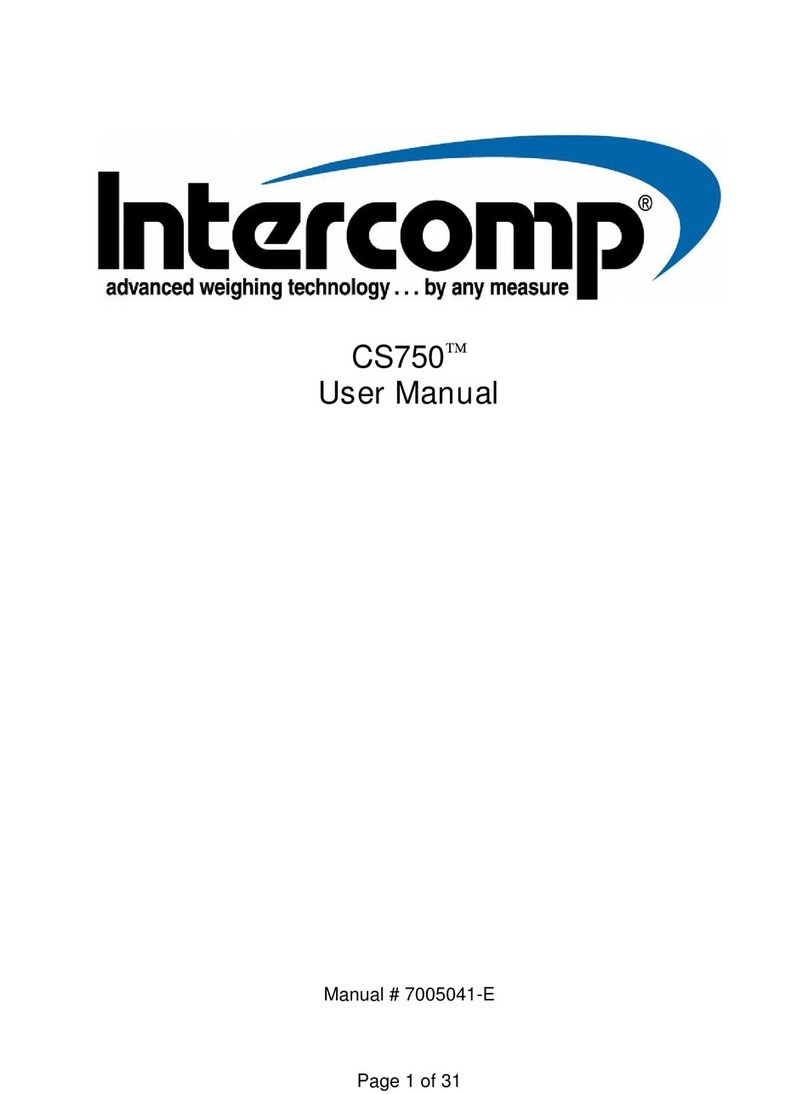
Intercomp
Intercomp CS750 User manual

Intercomp
Intercomp CS3000 User manual

Intercomp
Intercomp CS200 User manual
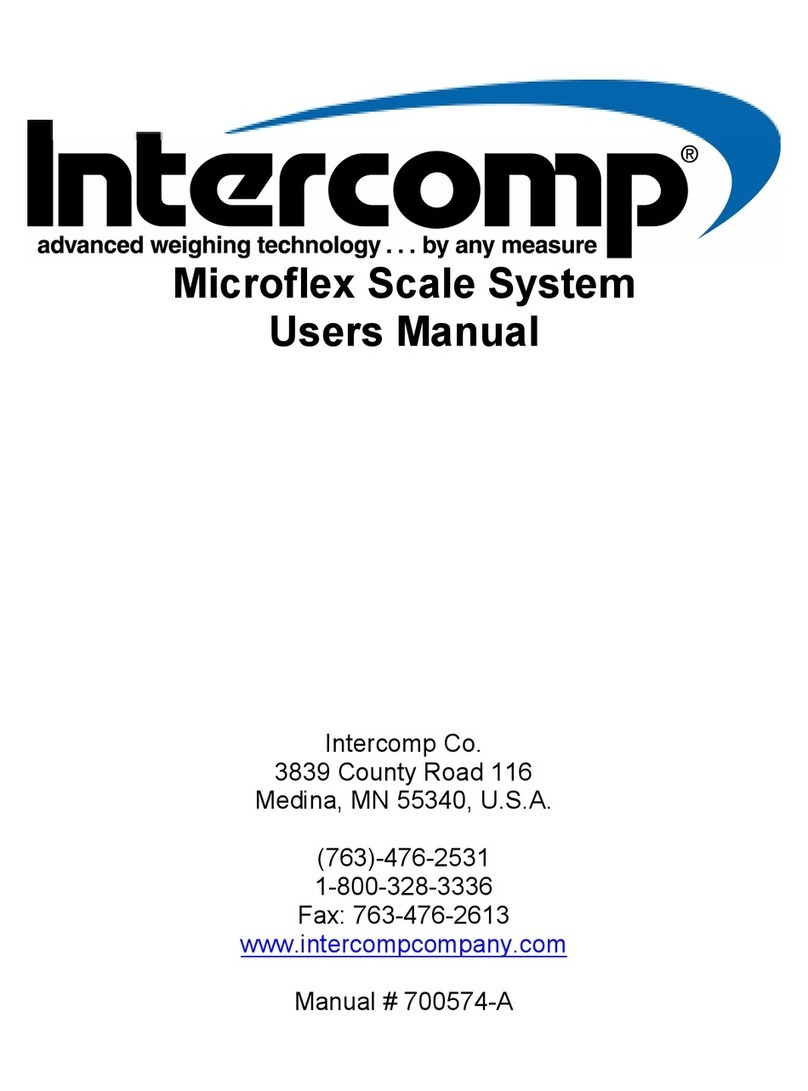
Intercomp
Intercomp Microflex User manual
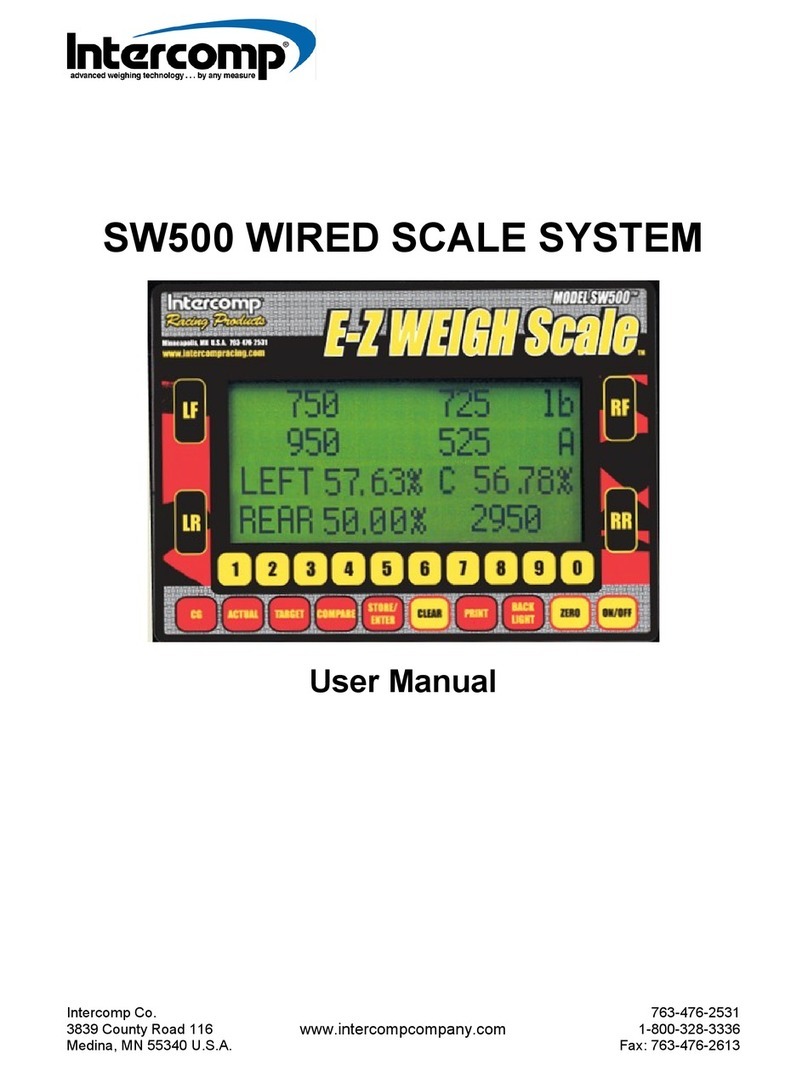
Intercomp
Intercomp SW500 User manual
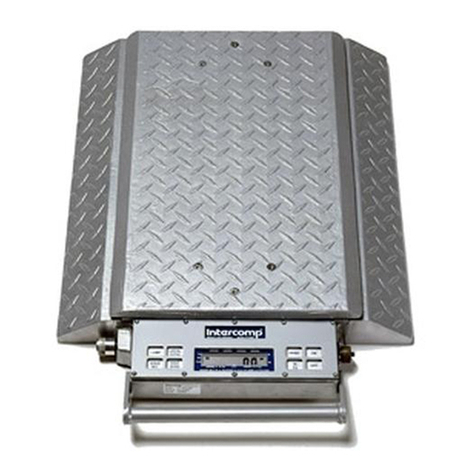
Intercomp
Intercomp PT300 User manual
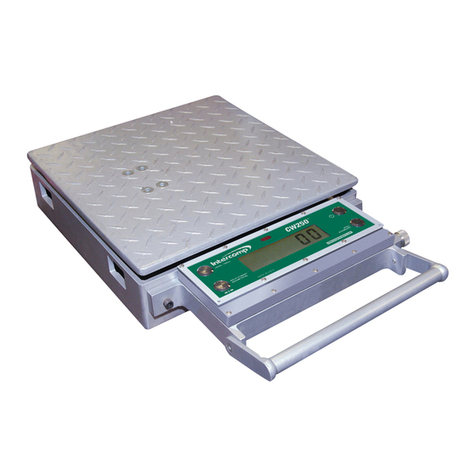
Intercomp
Intercomp CW250 User manual
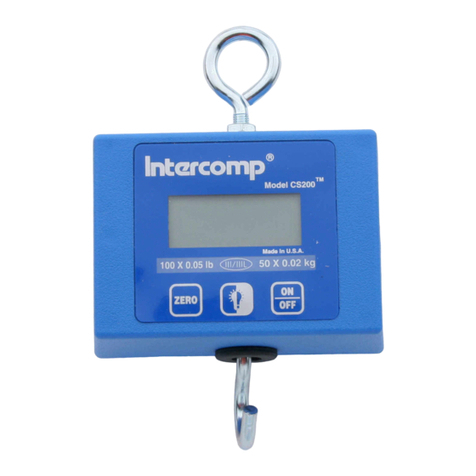
Intercomp
Intercomp CS200 User manual
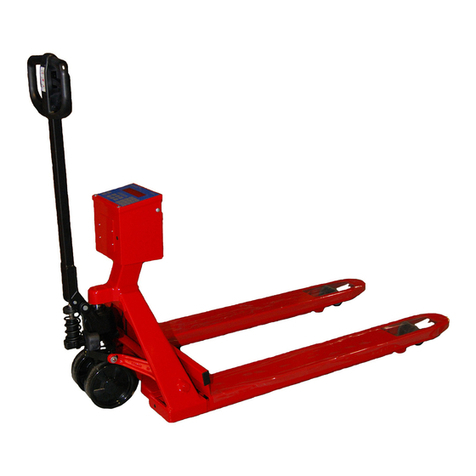
Intercomp
Intercomp PW800 User manual
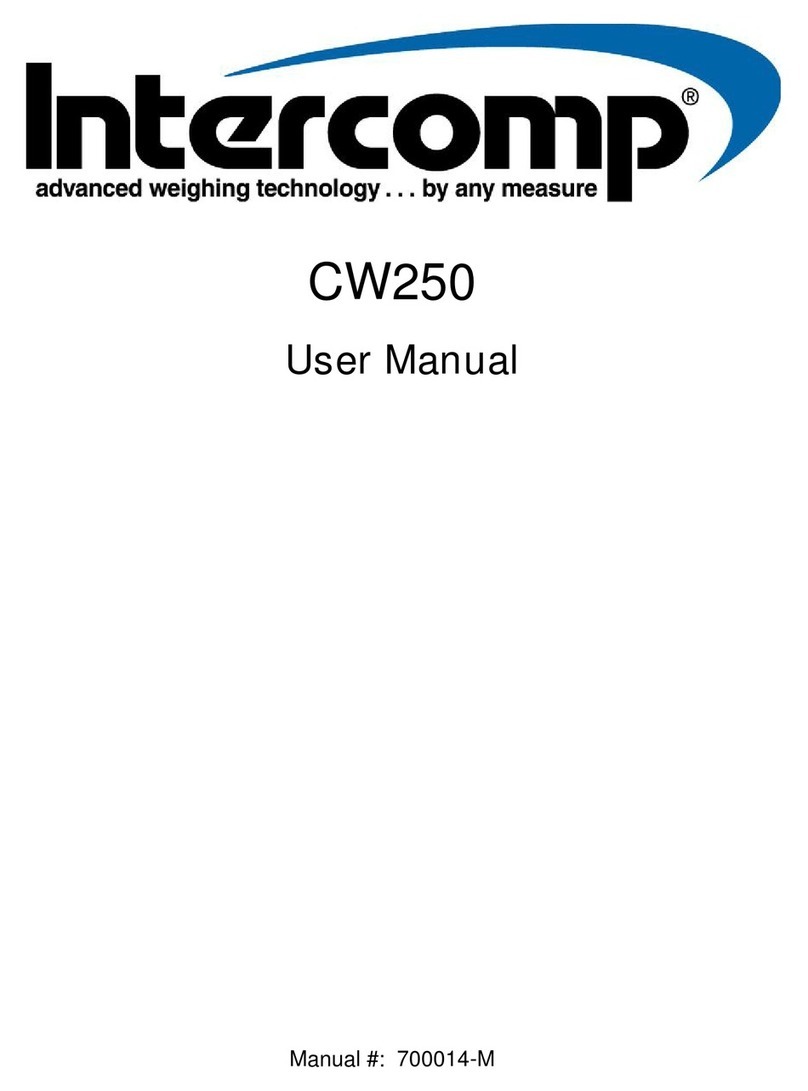
Intercomp
Intercomp CW250 User manual
